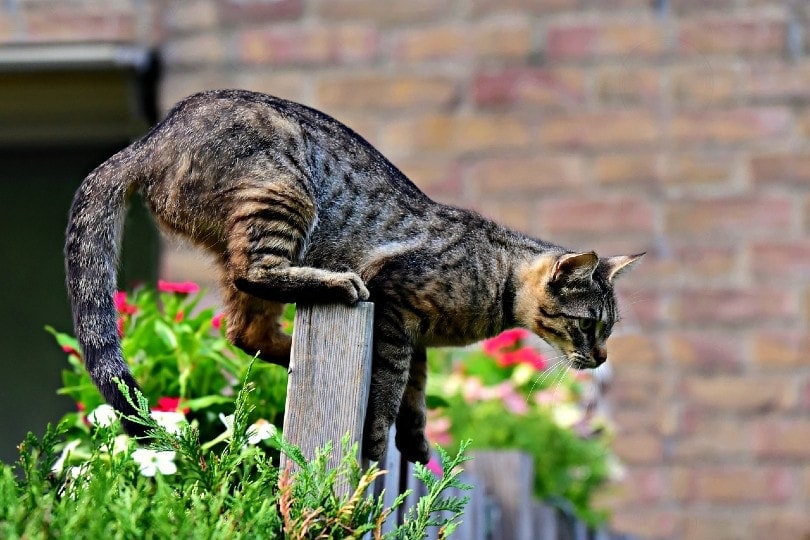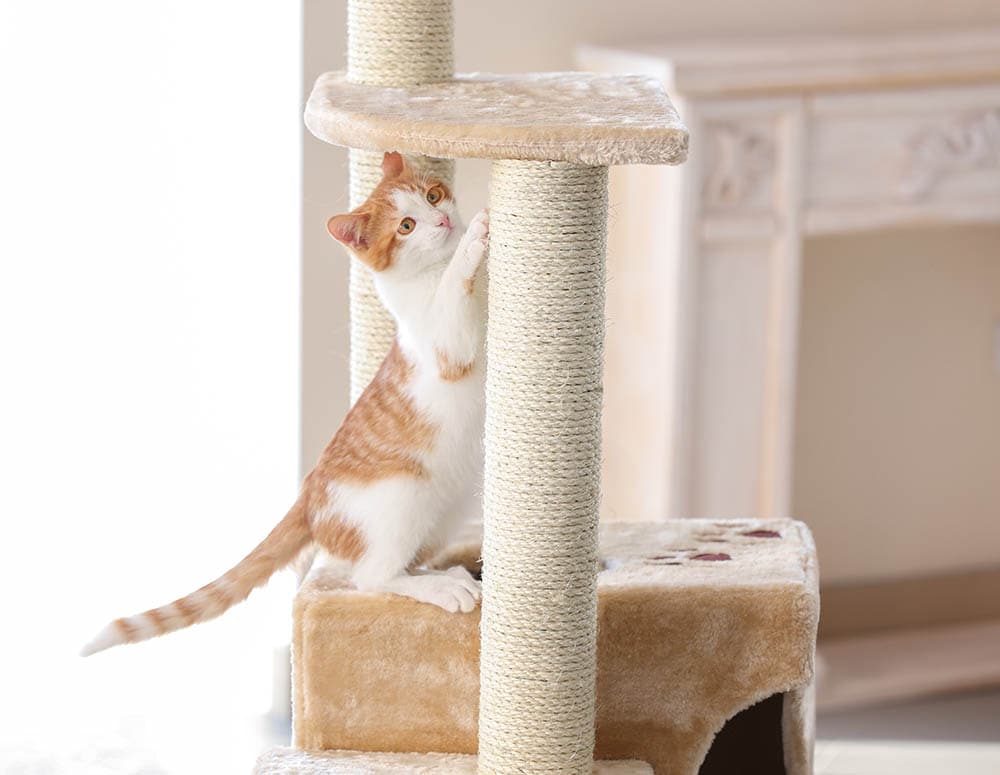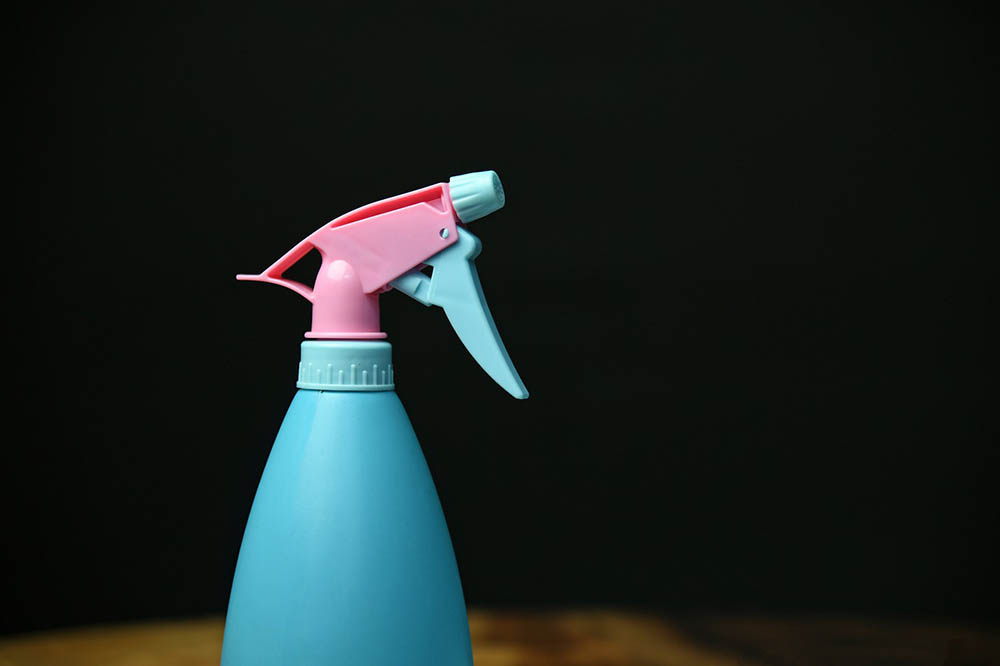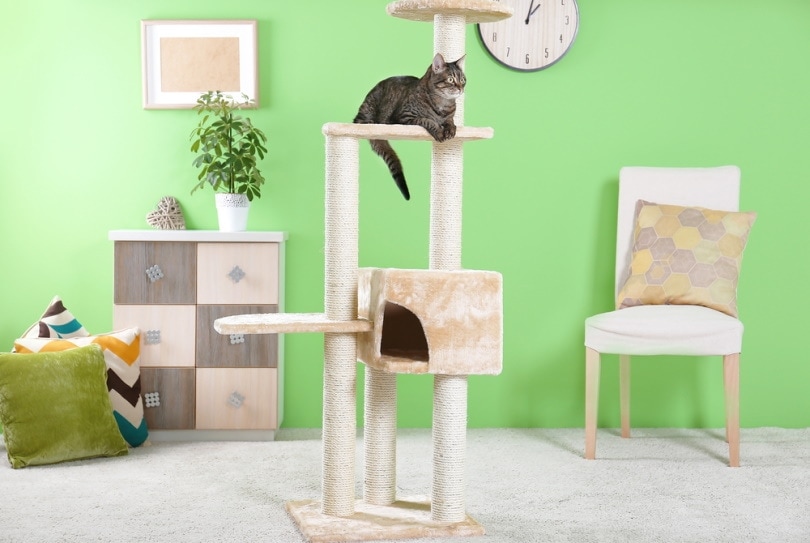How to Keep a Cat From Leaping Over a Gate: 9 Great Options

Updated on

Click to Skip Ahead
It’s natural for cats to climb and leap over obstacles, but your pet can get into trouble when it escapes over your gate or fence. Outdoor cats typically get more exercise than indoor kitties, but they’re more vulnerable to injuries from cruel humans, pest control devices, automobiles, and predatory wildlife.
However, your indoor pet can enjoy the confines of your property when you take steps to protect them from the dangers over the fence. Some fence modifications are inexpensive, but others, such as erecting a taller fence, require a significant investment. We’ll discuss how to keep your cat from leaping outdoor gates and indoor units.
Before You Start
Although most cats are curious and enjoy exploring, you can reduce the urge to leap over the gate by making the indoor environment more stimulating. Cat toys can keep your cat entertained, but they’re unlikely to deter the animal from jumping over the fence.
- A tall cat tree or cat run: A floor-to-ceiling cat tree can provide exercise and satisfy your pet’s urge to leap and climb. Most models include a stabilizing strap that attaches to the wall, but you should test the tree for stability before allowing your cat to play. A pricier alternative is to install a cat run along your wall. A Cat run is a series of platforms and bridges that allow your cat to exercise and play at higher elevations.
- Cardboard mazes: Online deliveries have become commonplace for most homeowners, and you can use the cardboard to entertain your pet before recycling the material. Cardboard towers and mazes are not aesthetically pleasing, but they’re easy to erect and modify.
- Spaying or neutering: Unless you’re in the breeding business, you can have your cat fixed to minimize the animal’s urge to leap over the fence and escape. Most vets will spay or neuter cats when they’re at least 6 months old.

The 6 Ways to Keep a Cat From Jumping Over an Outdoor Gate
Depending on the health and breed of the animal, most cats can leap 5 feet or more. Modifying your fencing can convince your pet to stay in the yard, but be sure to check your neighborhood’s HOA rules and covenants before making renovations. Some cat-proofing projects are expensive, and any structure that violates regulations will have to be dismantled.
1. Taller Fences
Building a new fence is an expensive project that costs several thousand dollars. However, your existing structure may be in poor shape, and you can install a new fence to improve your property’s appearance and increase your property value. Wooden fences are more expensive than vinyl models, and they require periodic weather sealing or varnishing to keep them in good shape. While vinyl is an affordable option that requires less maintenance, they’re usually not as sturdy as wood, and some homeowners consider them tacky.
2. Roller Bars
If you have a pet that excels at jumping and scaling tall fences, you can install roller bars that run along the top of the frame and gate. Cats can leap over short gates in a single bound, but they usually pause at the top of taller fences before jumping to the other side. Rollers prevent cats from balancing on the top, and you can find a style that matches your fence’s color and design. Metal tube models are better for chain link fences, but you can use the vinyl units for wood or vinyl fences.
3. Scat Mats
One of the most affordable techniques you can use to keep your cat off the fence is a spiked mat. Scat mats have rubber or plastic spikes that make the surface uncomfortable to the animal’s paws. The tips of the points are blunt and will not harm your pet. If you’re hesitant to drill into your fence to attach the mats, you can secure them in place with zip ties. Scat mats are excellent deterrents if they’re installed on a tall structure. Your cat can leap over the spikes if the fence is too low.
4. Netting
It’s not likely to help you win the best-looking yard of the year award, but fence netting can keep your cat in your yard. You can also use the net to prevent your pet from climbing trees and leaping onto your roof. Some homeowners have used chicken wire instead of netting, but the wire makes your property appear more like a prison yard than a home. You install the structure by attaching brackets around the fence and positioning the net, so it’s angled at 45 degrees. The downward slant of the net prevents cats from leaping or climbing over the top.
5. Cat Deterrents
You can find numerous commercial cat deterrents and DIY formulas online, but many of the sprays and homemade mixtures are ineffective at preventing fence leaping. If you spray a citrus blend or use a predator scent on the structure, your cat can still jump over the top. Liquid deterrents are more helpful in keeping animals away from areas they use for rest or to relieve themselves, such as porches, mulch beds, and gardens.
However, you can purchase a motion-activated sprinkler or noisemaker to prevent jumping. If you position several sprinklers around your yard, your cat will think twice before approaching the gate or fence. Motion-activated noisemakers can scare your cat away, but some units are so loud they can upset your neighbors.

6. Cat Runs
Attaching a cat run along your fence allows your pet to enjoy the outdoors and prevents escapes over the top. Cat runs consist of wire or plastic tubes that you position around the fence or yard like a miniature obstacle course. Before purchasing or building a run, measure your cat’s height to ensure the animal can run through the tubes without bumping its head.
The 3 Ways to Keep a Cat From Jumping Over an Indoor Gate
Indoor gates prevent small children and dogs from entering rooms, but some units are too short to prevent entries from felines. Several manufacturers make gates for cats out of wood, metal, and plastic, but very few of them can deter experienced leapers.
1. Tall Cat Gates
You can replace a short gate with a taller model that’s over 60 inches high. Most of the taller gates are around $100, but the durable models made of metal are more expensive. If you’re also trying to prevent infants from accessing a room, you can purchase a gate that’s rated for human and animal use. However, some customers have to reinforce the gates with brackets or fasteners when the opening has wood paneling around the base. Check the structure’s stability to prevent tipping before allowing children or pets in the room.
2. DIY Deterrents
A citrus spray or commercial indoor deterrent can encourage your pet to move in the opposite direction. You can mix water and lemon juice to spray on the gate to repel your cat, but it’s best to test the liquid in a small spot before saturating the entire structure. Citric acid can discolor wood and paint, but you can dilute the solution more with water to minimize the damage. Although the predator urine deterrents can keep cats away from gardens and porches, we do not recommend using them indoors.

3. Accordion Doors
Like cat gates, accordion doors restrict access to rooms, but they cover the entire opening. You can replace a standard door with an accordion unit that moves on tracks, or you can use a model that attaches to the wall temporarily with spring-loaded attachments. They do not offer as much privacy as typical wooden doors, but they allow air to flow into the room even the unit is closed.
Final Thoughts
Preventing a cat from leaping over a fence can seem pointless when your pet has world-class skills, but even the most intelligent and agile felines can be outwitted by their owners. Cats are unpredictable, but they generally follow a daily routine, including leaping over the gate. Until the fence is modified or replaced, your pet will continue to explore the world on the other side of the structure. Although some of the renovations seem pricey, they’ll keep your cat safe and prevent you from searching for your lost pet in the neighborhood.
Featured Image Credit: MabelAmber, Pixabay











